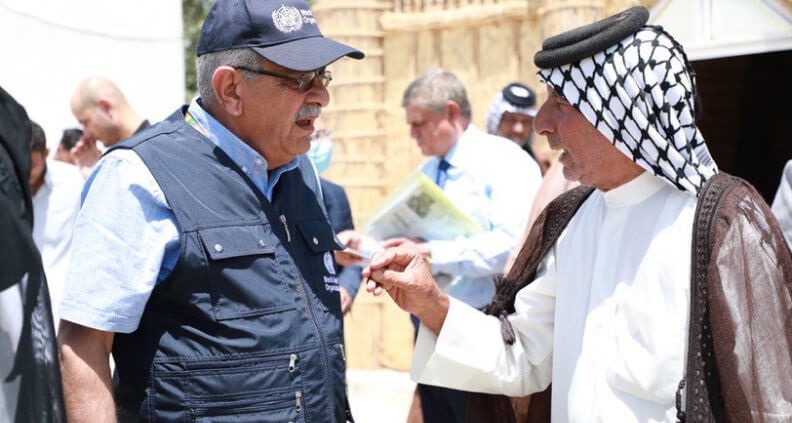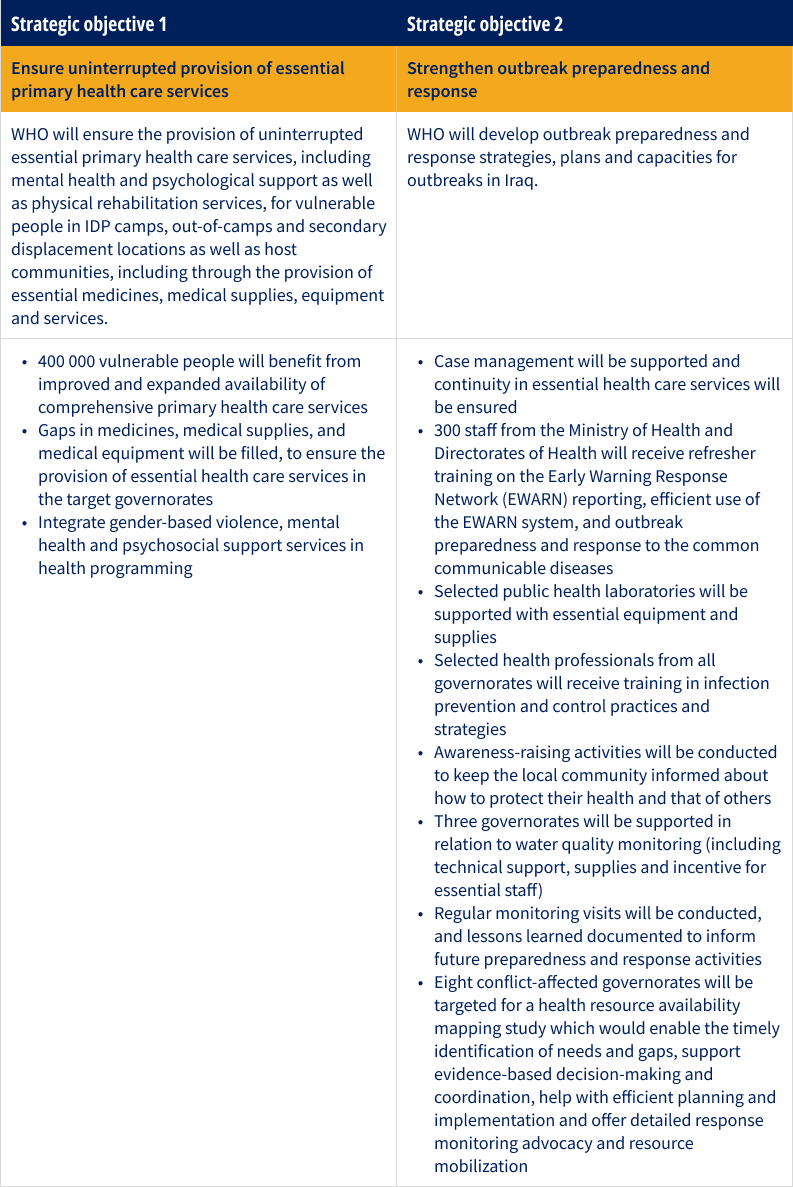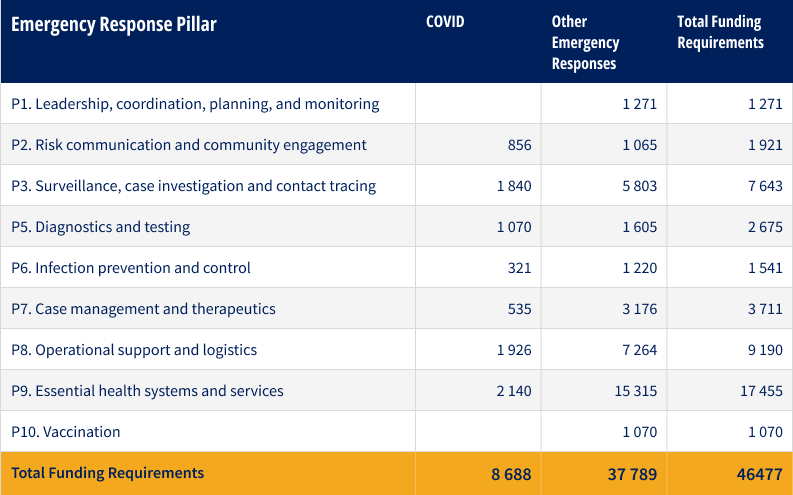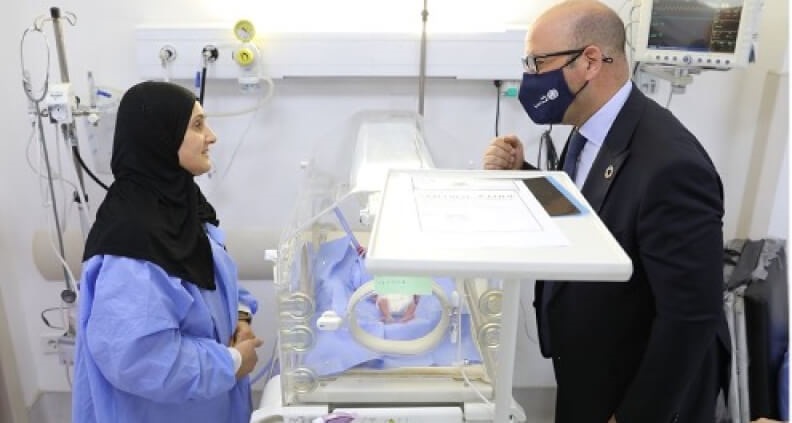
Iraq
Iraq
- People in need: 2.5 million people1
- People targeted: 1 million
- People in need of health assistance: 1.7 million
- Requirements (US$): 46.5 million
Context
Following years of devastating conflict and economic stagnation, an estimated 2.5 million people in Iraq remain in need of humanitarian assistance, and the country's health system continues to be negatively impacted by its consequences. In 2022, the country had over 180 000 internally displaced persons (IDPs) in camps, 549 000 out-of-camps and over 1.7 million returnees, who have minimum access to essential services. An estimated 578 000 IDPs and returnees are facing barriers in accessing lifesaving and life-sustaining health care as a result of primary health care centers being either nonexistent or located more than one hour from their dwellings. Moreover, almost all the displaced, resettled and host communities are vulnerable to common communicable and non-communicable diseases and psychological problems. In addition to the ongoing COVID-19 pandemic, the latest critical health risks of concern include Crimean-Congo hemorrhagic fever, cholera and measles. With over 30% of hospitals destroyed in some locations, and with a lack of government capacity to take over services from humanitarian partners, short-term humanitarian support alongside stabilization programs is required to meet the lifesaving and life-sustaining health needs of these vulnerable people.

WHO IRAQ Team Conducting Community Engagement Activities.
Emergency response
Despite the decision to deactivate the Humanitarian Response Plan (HRP) for 2023, needs remain in the area of health in Iraq. WHO therefore adapted its strategy to focus on the most vulnerable populations by sustaining essential primary health care (PHC) services in camps where health structures are already present. As part of this strategy, WHO is prioritizing informal settlements and any camps where the current partners may not be able to continue to support health services, where this is supported by the population size and where there is no option for IDPs to access health services in the public health facilities. WHO will focus on ensuring that the lifesaving and life-sustaining health needs of IDPs both within and outside camps are met, particularly in underserved areas.
WHO will also support the government in providing primary care services in locations where there is no functioning health system or its components. Reducing avoidable morbidity and mortality will remain a focus. To tackle this, WHO will offer treatment for common diseases and will ensure referrals of complicated cases, with a focus on mental health and psychosocial support services as well as the physical rehabilitation of amputees and those who have sustained disabilities or have been wounded during armed conflict. WHO intends to achieve this through operationalizing PHC centers, mobile medical clinics, and offering referral services in selected IDP and secondary displacement locations. Another key area of support will be to strengthen early detection and response to disease outbreaks and strengthen the health information management system.
Strategic objectives


Key activities
- Continue to support the provision of primary health care services to IDPs in camps, and continue to maintain and, where required, enhance basic minimum standards of quality of health care services
- Procure and distribute medicines, medical supplies and medical equipment
- Support the integration of mental health and psychosocial support services, and support gender-based violence interventions in health programming
- Work towards the handover/integration of emergency health services with routine health care services of the Directorates of Health
- Monitor, mitigate and manage common communicable diseases by ensuring the continuity of an effective early warning and response mechanism
- Support prevention, control and rapid response activities related to communicable and vaccine-preventable disease outbreaks in previously conflict-affected areas
- Conduct water quality monitoring and vector-control activities in IDP camps, informal settlements and highly vulnerable hosting communities
- Conduct risk communication and community engagement (RCCE) activities to keep the public informed about how to protect their health and that of others
- Conduct health resource availability mapping in selected governorates.

Dr Ahmed Zouiten WHO Representative to Iraq visiting Pediatrics Hospital, Duhok Iraq, 2022.
Funding requirements
Overall country funding requirements, including COVID-19, by pillar (US$’000)


Success stories
Harnessing social media and Risk Communication and Community Engagement (RCCE) to raise awareness of disease outbreaks across Iraq
Across Iraq, there have been serious outbreaks of Crimean-Congo hemorrhagic fever and cholera amongst the ongoing COVID-19 pandemic. In response, WHO has collaborated with the Ministry of Health to reach millions to raise awareness of the outbreaks and train communities to help their prevention.
Notably, this has been achieved through social media channels, including Instagram, Facebook, Twitter, YouTube and TikTok. Over the past year, dozens of high-quality videos, motion graphics, animations, cartoons, radio drama and infographics were produced in Arabic and Kurdish to disseminate awareness messages on different outbreaks affecting the country. Celebrities and community influencers were also engaged to help amplify these messages across platforms.
Risk Communication and Community Engagement (RCCE) workshops were also conducted, targeting hundreds of faith and tribal leaders, health workers, health educators and community volunteers across Iraq. These training workshops contributed substantially to help these groups communicate the importance of taking preventive measures against different diseases. Its activities helped build trust among communities by engaging them in and fostering their sense of ownership and accountability to take action to address health-related issues. WHO's response therefore adopted new trends and approaches to reach target audiences with eye-catching, appealing products and contextualized materials, considering Iraqi culture, norms and dialects.
For more information
Dr. Ahmed Zouiten | Representative and Head of Mission, WHO Iraq | zouitena@who.int

Dr Ahmed Zouiten WHO Representative to Iraq visiting Heevie Hospital, Dahuk.

WHO IRAQ Warehouse

